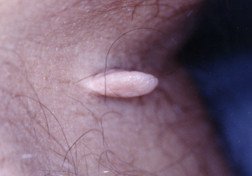Skin tags (acrochordon)
Medically reviewed by Drugs.com. Last updated on Sep 21, 2023.
What are Skin tags (acrochordon)?

A skin tag is a soft, skin-colored growth that hangs from the surface of the skin on a thin piece of tissue called a stalk. Its medical name is acrochordon. Skin tags are not skin cancers and cannot turn into skin cancers.
|
|
Skin tags typically appear as people age. They are quite common in people 60 and older. A tendency to develop skin tags may run in families. Skin tags often develop after weight gain or pregnancy.
Skin tags appear most often in skin folds of the neck, armpits, torso, beneath the breasts or in the genital region. They can become irritated if they are in an area where clothing or jewelry rubs against them, and they may be unsightly.
Symptoms
A skin tag at first may appear as a tiny soft bump on the skin. Over time, it grows into a flesh-colored piece of skin attached to the skin surface by a stalk. It's easy to move or wiggle a skin tag back and forth. A skin tag is painless, although it can become irritated if it is rubbed a lot.
If a skin tag is twisted on its stalk, a blood clot can develop within it and the skin tag may become painful.
Diagnosis
Doctors can recognize a skin tag easily by looking at it. For a skin tag with a characteristic appearance (soft, easily moveable, flesh-colored or slightly darker and usually attached to the skin surface by a stalk), you won't need any tests. If you notice that a skin growth is too firm to be wiggled easily, is a different color than surrounding skin, is multicolored or has raw or bleeding areas, ask your doctor to examine it. If it is not obvious that your skin growth is a skin tag, your doctor may want to do a biopsy, which means he or she will remove a small piece of skin to be examined in a laboratory.
Expected duration
Skin tags are permanent growths unless you have them removed. Many people develop multiple skin tags.
Prevention
There is no way to prevent skin tags.
Treatment
Doctors remove skin tags with sharp scissors, a sharp blade or, less commonly, by freezing or burning them off at the stalk. Bleeding can be stopped with a chemical (aluminum chloride) or electric (cauterizing) treatment.
Because skin tags are only a cosmetic concern, not a medical problem, most health insurance plans will not pay for their removal.
When to call a professional
Call your doctor if you notice that a suspected skin tag changes color or becomes painful.
Prognosis
The outlook for people with skin tags is excellent. They are not cancerous or precancerous growths, and they can be removed easily.
Additional info
American Academy of Dermatology
https://www.aad.org/
Further information
Always consult your healthcare provider to ensure the information displayed on this page applies to your personal circumstances.

